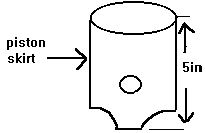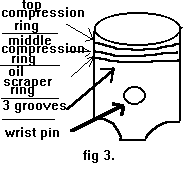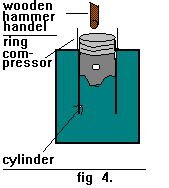
PISTONS,CONNECTING RODS,CYLINDERS



PISTONS |
|
|---|---|
| Pistons are round, and fit down into a cylinder. That's a round hole in the block . Pistons are about 4 inches round is an average size and are about 4 or 5 inches tall. (See fig. 1) |  |
| The length is called the skirt of the piston. The skirt's purpose is so the piston doesn't tip side ways in the cylinder . ( see fig . 2) |
 |
| If it didn't have a skirt or the lenght. It would be a thin round piece of metal just plugging up a hole and would tip side ways and would not work very well. It would be like when you cut the top out of a tin can. The top will fall side ways but, if it had sides it wouldn't. | |
| And each piston has at least 3 grooves with in the first inch or inch and a
half of the piston from the top down. (See fig. 3) These grooves are for rings. The two top grooves are for compression rings and the third one is an oil scraper ring. |
 |

| How to fit piston and rings into cylinder | |
|---|---|
| The rings are made of cast iron metal that have some spring to them. Because you have to squeese them together after you have them on the piston. With a ring compressor and then hit the top of the piston lightly to slide the piston down onto the cylinder and when the piston and rings side out of the ring compressor and into the cylinder the rings spring outward against the cylinder walls to make a air tight fit. (See fig. 4) | 
|

